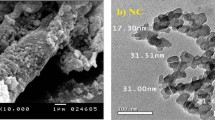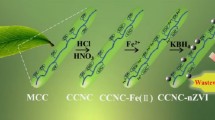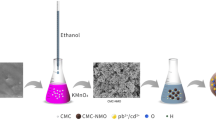Abstract
The progress of efficient wastewater treatment predominantly depends on materials fabrication. Polygonal magnetite nanoparticles (MNPs) were fabricated with 6–14 nm diameter by a developed co-precipitation approach, using non-toxic biotemplate bacterial cellulose (BC), biosynthesized by Gluconacetobacter xylinus (ATCC® 10245). The fabricated BC/MNPs composite was used for the removal of antimony (Sb (III)) from aqueous solution for the first time. The fabricated BC/MNPs-C was structurally characterized by Fourier-transform infrared spectrum (FTIR), X-ray diffraction (XRD), scanning electron microscope (SEM) and transmission electron microscope (TEM). BC/MNPs-C has a saturation magnetization of 55.15 emu g−1, surface area and pore size of 85.68 m2 g−1 and 60 nm, respectively, as determined using the Brunauer–Emmett–Teller method. Networks were basically mesoporous with pore sizes mostly < 60 nm and pore size distribution centered around 27 nm. Adsorption data were modeled using four adsorption isotherms, including Langmuir, Freundlich, Temkin and Dubinin–Radushkevich (D-R) models. The experimental data fitted Langmuir isotherm and followed pseudo-second-order kinetic model, indicating that the Sb (III) adsorption process occurred on homogenous monolayer, and it is chemically controlled via electrostatic attraction. The Sb (III) adsorption reached its equilibrium status within 60 min. EDXS analysis confirmed the presence of Sb (III) on the BC/MNPs-C surface. The fabricated BC/MNPs-C showed considerable regeneration capability and high performance after four successive cycles, with almost the same efficiency (88.7–93%). The overall work provides a green/simple method for bio-based nanocomposite preparation with excellent magnetic properties for the removal of antimony. As a result, the fabricated BC/MNPs-C could have important applications in many environmental and biological fields.
Graphical Abstract










Similar content being viewed by others
Abbreviations
- Sb (III):
-
Antimony
- AAS:
-
Atomic absorption spectrometry
- BC:
-
Bacterial cellulose
- EDX:
-
Energy-dispersive X-ray
- FETEM:
-
Field emission transmission electron microscopy
- FTIR:
-
Fourier-transform infrared spectrum
- Fe3O4 :
-
Magnetite
- BC/MNPs-C:
-
Bacterial cellulose/magnetite nanoparticles composite
- SEM:
-
Scanning electron microscope
- XRD:
-
X-ray diffraction
References
Abdalla MA, Jaafar MH, Al-Othman ZA, Alfadul SM, Khan MA (2011) New route for preparation and characterization of magnetite nanoparticles. Arab J Chem 4(2):235–237
Agarwal S, Tyagi I, Gupta VK, Fakhri A, Shahidi S (2017) Sonocatalytic, sonophotocatalytic and photocatalytic degradation of morphine using molybdenum trioxide and molybdenum disulfide nanoparticles photocatalyst. J Mol Liq 225:95–100
Ahn Y, Choi EJ, Kim EH (2003) Superparamagnetic relaxation in cobalt ferrite nanoparticles synthesized from hydroxide carbonate precursors. Rev Adv Mater Sci 5:477–480
Ali I, Aboul-Enein HY (2006) Instrumental methods in metal ions speciation: chromatography, capillary electrophoresis and electrochemistry. Taylor & Francis Ltd., New York
Ali I, Aboul-Enein HY, Gupta VK (2009) Nano chromatography and capillary electrophoresis: pharmaceutical and environmental analyses. John Wiley & Sons, Hoboken
Ali I, Alothman ZA, Alharbi OM (2016a) Uptake of pantoprazole drug residue from water using novel synthesized composite iron nano adsorbent. J Mol Liq 218:465–472
Ali I, Alothman ZA, Alwarthan A (2016b) Molecular uptake of congo red dye from water on iron composite nano particles. J Mol Liq 224:171–176
Ali I, Alothman ZA, Alwarthan A (2016c) Sorption, kinetics and thermodynamics studies of atrazine herbicide removal from water using iron nano-composite material. Int J Environ Sci Technol 13(2):733–742
Ali I, Alothman ZA, Alwarthan A (2017a) Uptake of propranolol on ionic liquid iron nanocomposite adsorbent: kinetic, thermodynamics and mechanism of adsorption. J Mol Liq 236:205–213
Ali I, Alothman ZA, Alwarthan A (2017b) Supra molecular mechanism of the removal of 17-β-estradiol endocrine disturbing pollutant from water on functionalized iron nano particles. J Mol Liq 241:123–129
Ali I, Alharbi OM, Alothman ZA, Badjah AY, Alwarthan A (2018) Artificial neural network modelling of amido black dye sorption on iron composite nano material: kinetics and thermodynamics studies. J Mol Liq 250:1–8
Almeida TP, Muxworthy AR, Williams W, Kasama T, Dunin-Borkowski RE (2014) Hydrothermal synthesis, off-axis electron holography and magnetic properties of Fe3O4 nanoparticles. J Phys Conf Ser 522:012062
Araneda C, Fonseca C, Sapag J, Basualto C, Yazdani-Pedram M, Kondo K, Kamio E, Valenzuela F (2008) Removal of metal ions from aqueous solutions by sorption onto microcapsules prepared by copolymerization of ethylene glycol dimethacrylate with styrene. Sep Purif Technol 63(3):517–523
Asfaram A, Ghaedi M, Agarwal S, Tyagi I, Gupta VK (2015) Removal of basic dye Auramine-O by ZnS: Cu nanoparticles loaded on activated carbon: optimization of parameters using response surface methodology with central composite design. RSC Adv 5(24):18438–18450
Barrón V, Torrent J (1996) Surface hydroxyl configuration of various crystal faces of hematite and goethite. J Colloid Interface Sci 177(2):407–410
Biswas K, Bandhoyapadhyay D, Ghosh UC (2007) Adsorption kinetics of fluoride on iron (III)-zirconium (IV) hybrid oxide. Adsorption 13(1):83–94
Boparai HK, Joseph M, O’Carroll DM (2011) Kinetics and thermodynamics of cadmium ion removal by adsorption onto nano zerovalent iron particles. J Hazard Mater 186(1):458–465
Cudennec Y, Lecerf A (2006) The transformation of ferrihydrite into goethite or hematite, revisited. J Solid State Chem 179(3):716–722
Dehghani MH, Sanaei D, Ali I, Bhatnagar A (2016) Removal of chromium (VI) from aqueous solution using treated waste newspaper as a low-cost adsorbent: kinetic modeling and isotherm studies. J Mol Liq 215:671–679
El-Baz AF, El-Batal AI, Abomosalam FM, Tayel AA, Shetaia YM, Yang ST (2016a) Extracellular biosynthesis of anti-Candida silver nanoparticles using Monascus purpureus. J Basic Microbiol 56(5):531–540
El-Baz AF, Sorour NM, Shetaia YM (2016b) Trichosporon jirovecii–mediated synthesis of cadmium sulfide nanoparticles. J Basic Microbiol 56(5):520–530
Essandoh M, Wolgemuth D, Pittman CU, Mohan D, Mlsna T (2017) Adsorption of metribuzin from aqueous solution using magnetic and nonmagnetic sustainable low-cost biochar adsorbents. Environ Sci Pollut Res 24(5):4577–4590
European Union (EU) (2014) Drinking water regulations, council directive 98/83/EC and 2000/60/EC on the quality of water intended for human consumption; L330/32 and 327/1; Official Journal of the European Union: Brussels, Belgium
Fakhri A, Rashidi S, Tyagi I, Agarwal S, Gupta VK (2016) Photodegradation of Erythromycin antibiotic by γ-Fe2O3/SiO2 nanocomposite: response surface methodology modeling and optimization. J Mol Liq 214:378–383
Foresti ML, Vázquez A, Boury B (2017) Applications of bacterial cellulose as precursor of carbon and composites with metal oxide, metal sulfide and metal nanoparticles: a review of recent advances. Carbohyd Polym 157:447–467
Freundlich H (1926) Colloid and capillary chemistry. Methuen, London
Giraldo L, Erto A, Moreno-Piraján JC (2013) Magnetite nanoparticles for removal of heavy metals from aqueous solutions: synthesis and characterization. Adsorption 19:465–474
Gnanasekaran L, Hemamalini R, Saravanan R, Ravichandran K, Gracia F, Agarwal S, Gupta VK (2017) Synthesis and characterization of metal (CeO2, CuO, NiO, Mn3O4, SnO2 and ZnO) oxides nanoparticles as photo catalysts for degradation of textile dyes. J Photochem Photobiol B 173:43–49
Guan XH, Zheng BT, Lu M, Guan X, Wang GS, Guo L (2012) Highly water-dispersible Fe3O4 single nanocrystals: gram-scale preparation by a solution-phase route and application for the absorption of Cd2+ in water. Chem Plus Chem 77(1):56–60
Gupta VK, Saravanan R, Agarwal S, Gracia F, Khan MM, Qin J, Mangalaraja RV (2017) Degradation of azo dyes under different wavelengths of UV light with chitosan-SnO2 nanocomposites. J Mol Liq 232:423–430
Hu J, Chen G, Lo IM (2006) Selective removal of heavy metals from industrial wastewater using maghemite nanoparticle: performance and mechanisms. J Environ Eng 132(7):709–715
Khalafalla S, Reimers G (1980) Preparation of dilution-stable aqueous magnetic fluids. IEEE Trans Magn 16(2):178–183
Kumar KY, Raj TV, Archana S, Prasad SB, Olivera S, Muralidhara HB (2016) SnO2 nanoparticles as effective adsorbents for the removal of cadmium and lead from aqueous solution: adsorption mechanism and kinetic studies. J Water Process Eng 13:44–52
Lee SH, Choi H, Kim KW (2016) Removal of As (V) and Sb (V) in water using magnetic nanoparticle-supported layered double hydroxide nanocomposites. J Geochem Explor. https://doi.org/10.1016/j.gexplo.2016.11.015
Leng Y, Guo W, Su S, Yi C, Xing L (2012) Removal of antimony (III) from aqueous solution by graphene as an adsorbent. Chem Eng J 211:406–411
Masaoka S, Ohe T, Sakota N (1993) Production of cellulose from glucose by Acetobacter xylinum. J Fermen Bioeng 75:18–22
Mascolo MC, Pei Y, Ring TA (2013) Room temperature co-precipitation synthesis of magnetite nanoparticles in a large pH window with different bases. Materials 6(12):5549–5567
Nagarajah R, Wong KT, Lee G, Chu KH, Yoon Y, Kim NC, Jang M (2017) Synthesis of a unique nanostructured magnesium oxide coated magnetite cluster composite and its application for the removal of selected heavy metals. Sep Purif Technol 174:290–300
Nassar NN, Hassan A, Pereira-Almao P (2011) Metal oxide nanoparticles for asphaltene adsorption and oxidation. Energy Fuels 25(3):1017–1023
Nekouei F, Nekouei S, Tyagi I, Gupta VK (2015) Kinetic, thermodynamic and isotherm studies for acid blue 129 removal from liquids using copper oxide nanoparticle-modified activated carbon as a novel adsorbent. J Mol Liq 201:124–133
Nikfar E, Dehghani MH, Mahvi AH, Rastkari N, Asif M, Tyagi I, Agarwal S, Gupta VK (2016) Removal of bisphenol A from aqueous solutions using ultrasonic waves and hydrogen peroxide. J Mol Liq 213:332–338
Olivera S, Muralidhara HB, Venkatesh K, Guna VK, Gopalakrishna K, Kumar Y (2016) Potential applications of cellulose and chitosan nanoparticles/composites in wastewater treatment: a review. Carbohyd Polym 153:600–618
Rajput S, Pittman CU, Mohan D (2016) Magnetic magnetite (Fe3O4) nanoparticle synthesis and applications for lead (Pb2+) and chromium (Cr6+) removal from water. J Colloid Interface Sci 468:334–346
Rangel-Mendez JR, Streat M (2002) Adsorption of cadmium by activated carbon cloth: influence of surface oxidation and solution pH. Water Res 36(5):1244–1252
Santhosh C, Velmurugan V, Jacob G, Jeong SK, Grace AN, Bhatnagar A (2016) Role of nanomaterials in water treatment applications: a review. Chem Eng J 306:1116–1137
Saravanan R, Khan MM, Gupta VK, Mosquera E, Gracia F, Narayanan V, Stephen A (2015) ZnO/Ag/Mn2O3 nanocomposite for visible light-induced industrial textile effluent degradation, uric acid and ascorbic acid sensing and antimicrobial activity. RSC Adv 44:34645–34651
Saravanan R, Khan MM, Gracia F, Qin J, Gupta VK, Arumainathan S (2016) Ce3+ion-induced visible-light photocatalytic degradation and electrochemical activity of ZnO/CeO2 nanocomposite. Nat Sci Rep 6:31641
Shan C, Ma Z, Tong M (2014) Efficient removal of trace antimony (III) through adsorption by hematite modified magnetic nanoparticles. J Hazard Mater 268:229–236
Stoica-Guzun A, Stroescu M, Jinga SI, Mihalache N, Botez A, Matei C, Berger D, Damian CM, Ionita V (2016) Box-Behnken experimental design for chromium (VI) ions removal by bacterial cellulose-magnetite composites. Int J Biol Macromol 91:1062–1072
Su C (2017) Environmental implications and applications of engineered nanoscale magnetite and its hybrid nanocomposites: a review of recent literature. J Hazard Mater 322:48–84
Sun J, Zhou S, Hou P, Yang Y, Weng J, Li X, Li M (2007) Synthesis and characterization of biocompatible Fe3O4 nanoparticles. J Biomed Mater Res Part A 80(2):333–341
Szymańska-Chargot M, Cybulska J, Zdunek A (2011) Sensing the structural differences in cellulose from apple and bacterial cell wall materials by Raman and FT-IR spectroscopy. Sensors 11(6):5543–5560
Tan G, Xiao D (2009) Adsorption of cadmium ion from aqueous solution by ground wheat stems. J Hazard Mater 164(2):1359–1363
Unuabonah EI, Adebowale KO, Olu-Owolabi BI (2007) Kinetic and thermodynamic studies of the adsorption of lead (II) ions onto phosphate-modified kaolinite clay. J Hazard Mater 144(1):386–395
US Environmental Protection Agency (US EPA) (2012) Edition of the Drinking Water Standards and Health Advisories; Office of Water. US Environmental Protection Agency, Washington
Wang H, Zhou A, Peng F, Yu H, Yang J (2007) Mechanism study on adsorption of acidified multiwalled carbon nanotubes to Pb(II). J Colloid Interface Sci 316(2):277–283
Wang XS, Lu HJ, Zhu L, Liu F, Ren JJ (2010) Adsorption of lead (II) ions onto magnetite nanoparticles. Adsorpt Sci Technol 5:407–417
World Health Organization (WHO) (2017) Antimony in drinking-water; WHO guidelines for drinking-water quality. In: Fourth edition incorporating first addendum; World Health Organization: Geneva, Switzerland. Licence: CC BY-NC-SA 3.0 IGO. http://apps.who.int/iris
Yu S, Zhai L, Zhong S, Qiu Y, Cheng L, Ren X (2016) Synthesis and structural characterization of magnetite/sepiolite composite and its sorptive properties for Co (II) and Cd (II). J Taiwan Inst Chem Eng 59:221–228
Zhang D, Qi L (2005) Synthesis of mesoporous titania networks consisting of anatase nanowires by templating of bacterial cellulose membranes. Chem Commun 21:2735–2737
Zhang T, Wang W, Zhang D, Zhang X, Ma Y, Zhou Y, Qi L (2010) Biotemplated synthesis of gold nanoparticle–bacteria cellulose nanofiber nanocomposites and their application in biosensing. Adv Func Mater 20(7):1152–1160
Zhou J, Li R, Liu S, Li Q, Zhang L, Zhang L, Guan J (2009) Structure and magnetic properties of regenerated cellulose/Fe3O4 nanocomposite films. J Appl Polym Sci 111(5):2477–2484
Zhu H, Jia S, Wan T, Jia Y, Yang H, Li J, Yan L, Zhong C (2011) Biosynthesis of spherical Fe3O4/bacterial cellulose nanocomposites as adsorbents for heavy metal ions. Carbohyd Polym 86(4):1558–1564
Acknowledgements
The corresponding author thankfully acknowledges the cooperation of the team for completeness of this research, revising manuscript and helpful discussion. The authors wish to thank also Department of Industrial Biotechnology, Genetic Engineering and Biotechnology Research Institute at University of Sadat City, for their support and equipping the laboratory to carry out this research work.
Author information
Authors and Affiliations
Corresponding author
Ethics declarations
Conflict of interest
All authors declare that there are no financial/commercial conflicts of interest.
Additional information
Editorial responsibility: V.K. Gupta.
Rights and permissions
About this article
Cite this article
Hassan, A., Sorour, N.M., El-Baz, A. et al. Simple synthesis of bacterial cellulose/magnetite nanoparticles composite for the removal of antimony from aqueous solution. Int. J. Environ. Sci. Technol. 16, 1433–1448 (2019). https://doi.org/10.1007/s13762-018-1737-4
Received:
Revised:
Accepted:
Published:
Issue Date:
DOI: https://doi.org/10.1007/s13762-018-1737-4




